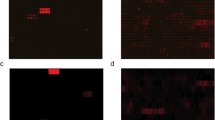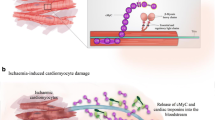Abstract
Human enteroviruses, e.g. coxsackieviruses, induce a variety of severe acute and chronic forms of disease, including myocarditis, meningitis and diabetes mellitus type 1. To visualize enterovirus infection with a diagnostic intent, many studies have applied a commercially available antibody (anti-CVB5 VP1, clone 5-D8/1, Dako, Hamburg, Germany) that identifies VP1 of different enteroviral serotypes. Many antibodies, however, have been found to bind non-specifically to proteins of cardiomyocytes and in the interstitial space, resulting in non-specific staining in immunohistochemistry. In this paper we show that the anti-CVB5 VP1 antibody, recognizing VP1 of coxsackieviruses and widely used in diagnostics and research, shows strong cross-reactivity with cellular proteins in the heart (and pancreas) of humans and mice, which calls for a more specific antibody to be used for diagnostic purposes. We observed by Western blot analyses of lysates from human heart tissue samples and HeLa cells two cross-reactive bands when using clone 5-D8/1. Peptide mass fingerprinting (MALDI-TOF) identified these proteins as creatine kinase (B-type) and tubulin, confirming that this mAb detects cellular proteins in addition to viral VP1. In order to overcome the problems of false positive VP1 staining we generated a new highly specific and sensitive monoclonal antibody (Cox mAB 31A2) that recognizes VP1 from CVB3. The new antibody was characterized and was found to function well in immunohistochemistry, immunofluorescence staining, Western blotting, ELISA and FACS analyses.






Similar content being viewed by others
References
Andreoletti L, Bourlet T, Moukassa D, Rey L, Hot D, Li Y, Lambert V, Gosselin B, Mosnier JF, Stankowiak C, Wattre P (2000) Enteroviruses can persist with or without active viral replication in cardiac tissue of patients with end-stage ischemic or dilated cardiomyopathy. J Infect Dis 182:1222–1227. doi:10.1086/315818
Andreoletti L, Hober D, Becquart P, Belaich S, Copin MC, Lambert V, Wattre P (1997) Experimental CVB3-induced chronic myocarditis in two murine strains: evidence of interrelationships between virus replication and myocardial damage in persistent cardiac infection. J Med Virol 52:206–214
Aretz HT (1987) Myocarditis: the Dallas criteria. Hum Pathol 18:619–624
Blauwet LA, Cooper LT Myocarditis Prog Cardiovasc Dis 52:274–288. doi:10.1016/j.pcad.2009.11.006
Blum H, Beier H, Gross HJ (1987) Improved silver staining of plant proteins. RNA and DNA in polyacrylamide gels Electrophoresis 8:93–99. doi:10.1002/elps.1150080203
Bordeaux J, Welsh A, Agarwal S, Killiam E, Baquero M, Hanna J, Anagnostou V, Rimm D (2010) Antibody validation BioTechniques 48:197–209. doi:10.2144/000113382
Caforio AL, Tona F, Bottaro S, Vinci A, Dequal G, Daliento L, Thiene G, Iliceto S (2008) Clinical implications of anti-heart autoantibodies in myocarditis and dilated cardiomyopathy. Autoimmunity 41:35–45. doi:10.1080/08916930701619235
Cunningham MW, Antone SM, Gulizia JM, McManus BM, Fischetti VA, Gauntt CJ (1992) Cytotoxic and viral neutralizing antibodies crossreact with streptococcal M protein, enteroviruses, and human cardiac myosin. Proc Natl Acad Sci U S A 89:1320–1324
de StGroth SF, Scheidegger D (1980) Production of monoclonal antibodies: strategy and tactics. J Immunol Methods 35:1–21
Hansson SF, Korsgren S, Ponten F, Korsgren O (2013) Enteroviruses and the pathogenesis of type 1 diabetes revisited: cross-reactivity of enterovirus capsid protein (VP1) antibodies with human mitochondrial proteins. J Pathol 229:719–728. doi:10.1002/path.4166
Klingel K, Hohenadl C, Canu A, Albrecht M, Seemann M, Mall G, Kandolf R (1992) Ongoing enterovirus-induced myocarditis is associated with persistent heart muscle infection: quantitative analysis of virus replication, tissue damage, and inflammation. Proc Natl Acad Sci U S A 89:314–318
Klingel K, Sauter M, Bock CT, Szalay G, Schnorr JJ, Kandolf R (2004) Molecular pathology of inflammatory cardiomyopathy. Med Microbiol Immunol 193:101–107. doi:10.1007/s00430-003-0190-1
Klingel K, Stephan S, Sauter M, Zell R, McManus BM, Bultmann B, Kandolf R (1996) Pathogenesis of murine enterovirus myocarditis: virus dissemination and immune cell targets. J Virol 70:8888–8895
Laemmli UK (1970) Cleavage of structural proteins during the assembly of the head of bacteriophage T4. Nature 227:680–685
Li Y, Bourlet T, Andreoletti L, Mosnier JF, Peng T, Yang Y, Archard LC, Pozzetto B, Zhang H (2000) Enteroviral capsid protein VP1 is present in myocardial tissues from some patients with myocarditis or dilated cardiomyopathy. Circulation 101:231–234
McManus BM, Chow LH, Radio SJ, Tracy SM, Beck MA, Chapman NM, Klingel K, Kandolf R (1991) Progress and challenges in the pathological diagnosis of myocarditis. Eur Heart J 12(Suppl D):18–21
Melnick J (1996) Enteroviruses: poliovirus, coxsackieviruses, echoviruses and newer enteroviruses. In: Fields BN, Knipe D, Howley P (eds) Fields virology. Lippincott-Raven, New York, pp. 655–712
Mercalli A, Lampasona V, Klingel K, Albarello L, Lombardoni C, Ekstrom J, Sordi V, Bolla A, Mariani A, Bzhalava D, Dillner J, Roivainen M, Bosi E, Piemonti L No evidence of enteroviruses in the intestine of patients with type 1 diabetes. Diabetologia 55:2479–2488. doi:10.1007/s00125-012-2591-4
Pankuweit S, Klingel K (2013) Viral myocarditis: from experimental models to molecular diagnosis in patients. Heart Fail Rev 18:683–702. doi:10.1007/s10741-012-9357-4 Review
Pisapia DJ, Lavi E (2016) VZV, temporal arteritis, and clinical practice: false positive immunohistochemical detection due to antibody cross-reactivity. Exp Mol Pathol 100:114–115. doi:10.1016/j.yexmp.2015.12.007
Richardson SJ, Leete P, Dhayal S, Russell MA, Oikarinen M, Laiho JE, Svedin E, Lind K, Rosenling T, Chapman N, Bone AJ, Foulis AK, Frisk G, Flodstrom-Tullberg M, Hober D, Hyoty H, Morgan NG (2014) Evaluation of the fidelity of immunolabelling obtained with clone 5D8/1, a monoclonal antibody directed against the enteroviral capsid protein, VP1, in human pancreas. Diabetologia 57:392–401. doi:10.1007/s00125-013-3094-7
Richardson SJ, Willcox A, Bone AJ, Foulis AK, Morgan NG (2009) The prevalence of enteroviral capsid protein vp1 immunostaining in pancreatic islets in human type 1 diabetes. Diabetologia 52:1143–1151. doi:10.1007/s00125-009-1276-0
Roivainen M, Klingel K (2009) Role of enteroviruses in the pathogenesis of type 1 diabetes. Diabetologia 52:995–996. doi:10.1007/s00125-009-1332-9
Rotbart HA (1995) Enteroviral infections of the central nervous system. Clin Infect Dis 20:971–981
Samuelson A, Forsgren M, Johansson B, Wahren B, Sallberg M (1994) Molecular basis for serological cross-reactivity between enteroviruses. Clin Diagn Lab Immunol 1:336–341
Samuelson A, Forsgren M, Sallberg M (1995) Characterization of the recognition site and diagnostic potential of an enterovirus group-reactive monoclonal antibody. Clin Diagn Lab Immunol 2:385–386
Schultz JC, Hilliard AA, Cooper LT Jr, Rihal CS (2009) Diagnosis and treatment of viral myocarditis. Mayo Clin Proc 84:1001–1009. doi:10.1016/S0025-6196(11)60670-8
Steinke K, Sachse F, Ettischer N, Strutz-Seebohm N, Henrion U, Rohrbeck M, Klosowski R, Wolters D, Brunner S, Franz WM, Pott L, Munoz C, Kandolf R, Schulze-Bahr E, Lang F, Klingel K, Seebohm G (2013) Coxsackievirus B3 modulates cardiac ion channels. FASEB J 27:4108–4121. doi:10.1096/fj.13-230193
Ursu ON, Sauter M, Ettischer N, Kandolf R, Klingel K (2014) Heme oxygenase-1 mediates oxidative stress and apoptosis in coxsackievirus B3-induced myocarditis cellular. Physiology and Biochemistry 33:52–66
Werner S, Klump WM, Schonke H, Hofschneider PH, Kandolf R (1988) Expression of coxsackievirus B3 capsid proteins in Escherichia coli and generation of virus-specific antisera. DNA 7:307–316
Yousef GE, Brown IN, Mowbray JF (1987) Derivation and biochemical characterization of an enterovirus group-specific monoclonal antibody. Intervirology 28:163–170
Yousef GE, Mann GF, Brown IN, Mowbray JF (1987) Clinical and research application of an enterovirus group-reactive monoclonal antibody. Intervirology 28:199–205
Acknowledgments
This work was supported in part by grants of the DFG (KL 595/2-3) and the German Federal Ministry of Education and Research (BMBF ID 13EZ0817). The authors thank Sandra Bundschuh for excellent technical assistance.
Author information
Authors and Affiliations
Corresponding author
Ethics declarations
For the technical investigations we used leftover material which was not required any more for routine diagnosis of cardiac diseases (Kandolf R et al., Eur Heart J. 1991 Aug;12 Suppl D:49–55) and from mouse studies (Gruhle S et al., Basic Res Cardiol. 2012 Sep.;107(5):287).
Disclosure/Conflict of interest
A. Normann and B. Flehmig are employees of Mediagnost, Reutlingen, Germany. Mediagnost, Germany did not participate in the study design, data collection, data analysis, data interpretation, decision to publish or funding. K Klingel received a honorarium for a staff training lecture from Mediagnost. All other authors have no conflicts of interest to declare.
Electronic supplementary material
Suppl. File 1
(DOCX 24 kb)
Suppl. File 2
(PPTX 1212 kb)
Rights and permissions
About this article
Cite this article
Ettischer-Schmid, N., Normann, A., Sauter, M. et al. A new monoclonal antibody (Cox mAB 31A2) detects VP1 protein of coxsackievirus B3 with high sensitivity and specificity. Virchows Arch 469, 553–562 (2016). https://doi.org/10.1007/s00428-016-2008-8
Received:
Revised:
Accepted:
Published:
Issue Date:
DOI: https://doi.org/10.1007/s00428-016-2008-8




